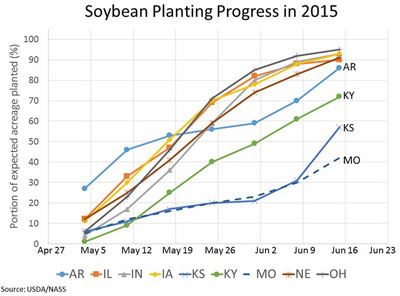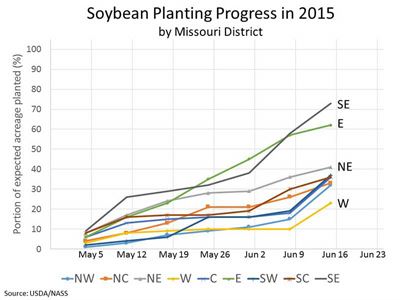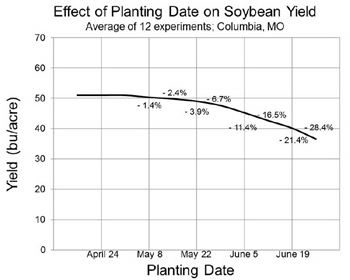Slow Soybean Planting Progress In Missouri And Impact On Yield
DR. WILLIAM J. WIEBOLD
COLUMBIA, MO.
Misery may love company, but there is not much company and far too much misery for Missouri soybean farmers. Figure 1 provides planting progress information for nine states including Missouri. As of June 14 only 42 percent of intended soybean acres had been planted in Missouri. This is the lowest number of all 9 states. Farmers in states to the north and east of Missouri have planted more than 90 percent of their planned acres.
The weather forecast does not bode well for Missouri farmers. As much as 5 inches of rain are predicted for the next several days. Then, tropical storm Bill will move from Texas into Missouri with additional heavy precipitation. The Missouri Climate Center has a list of links that allow you to view river/stream flooding possibilities (http://agebb.missouri.edu/weather/river.htm). Unfortunately, flood stage levels of our rivers are likely to stay with us for the foreseeable future.
Figure 2 provides soybean planting progress within the 9 MASS reporting districts. Over the past month there have been differences within Missouri for frequency of rain events. The eastern side of Missouri has had a few (very few) more days of planting opportunity than the western side. The “best” progress is in the SE, E, and NE districts. But, regardless of location, soybean planting lags behind normal and yield potential surely has been reduced.
Figure 3 presents soybean yield response to planting date averaged over 12 experiments conducted in central Missouri. Soybean yield is highly related to weather conditions during August, and yield variability among years for June planted soybean was large. Average yield for soybean planted in the third week of June is at least 25 percent less than when soybean was planted in early May. Intended soybean acreage in Missouri was estimated to be 5.65 million acres. Over 3 million acres are yet to be planted. Missouri farmers are experiencing a triple whammy of prevented corn planting, delayed soybean planting, and poor crop vigor because of cloudy skies and wet soil. ∆
DR. WILLIAM J. WIEBOLD: Professor, Division of Plant Sciences, University of Missouri


